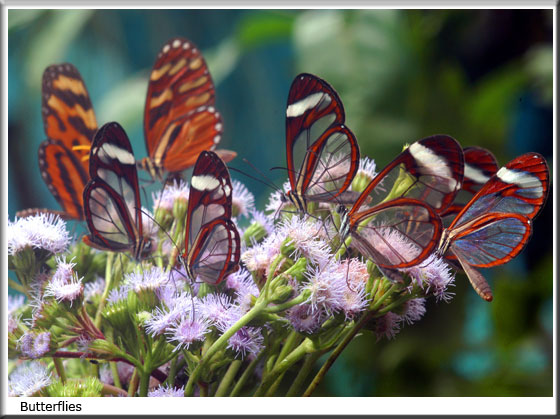 |
| Diversity amongst one species of butterfly |
 |
| Monarch Butterfly's Migration Pathways |
Butterflies first appear in the fossil record during the Eocene Epoch (50 Mya), which is about the same time period that modern grasses and forbs were beginning to break from the shadows of the forests that covered much of the planet. This means that these grasses and flowers co-evolved with the first butterflies, making them forever linked in existence to each other. Certain plant species, undoubtedly, evolved without the aid of bee species, making them undesirable for bee pollination. This is why it comes as no surprise that certain native wildflower populations have declined at a similar rate as the butterfly communities they rely on.
 | ||||
| Monarch Butterfly on a milkweed plant. |
A perfect example of this co-evolution/co-endangerment of two species is the case of Fender's Blue Butterfly (Icaricia icarioides fender) and Kincaid's Lupine (Sulphur Lupine). This type of butterfly has a very unique life cycle which takes longer to reach reproductive maturity than most species, making them especially vulnerable to biodiversity threats. The video below describes the Fender's life cycle and its association with Kincaid's Lupine.
This example shows just how intricate some of these species relationships are and how much they rely on one another for survival. In a study done at Oregon State University, the researchers found a distinct correlation between the number of butterflies and the number of its associated host plant. If one of these species is reduced in number, there will be a similar reduction in the other. The main threats that are effecting butterfly species are habitat destruction, pollution and pesticide misuse.
While, bees and butterflies have many differences, the challenges their species face are nearly identical. Habitat loss is the one with the most effect on butterflies however. Most of the habitat destruction occurs from changing the land use to agricultural or development purposes. Habitat loss has such a dramatic effect because it limits the nectar and pollen sources available to the butterflies and also eliminates vital nectar corridors for species traveling long distances rely upon as resting and breeding areas along their way. Butterfly's unique ecosystem services can no longer be ignored or the other species's extinctions will soon be collateral damage of our flawed conservation system. A more ecological approach must be taken, where protection of the butterflies will protect the areas and plants that they inhabit rather than having to choose between species.
New restoration strategies must be formulated to keep butterfly and host plant populations healthy. Butterflies can act as "umbrella species" that protect more than one species. By using butterflies in this manner they will provide an even larger cultural ecosystem service than they already do. They would become a symbol of its declining habitat and the symbiotic relationship it shares with its habitat. One of the new methods we can employ could be having private homes and schools begin to breed native butterflies for educational purposes. Unlike bees, butterflies are never going to harm you and most of them rely on beautiful, native flower and fruit species for their survival. Small steps towards restoration will have huge impacts for certain species, like Fender's Blue, and can easily be achieved by the individual. All it takes is a small bit of education to make a difference for an endangered species.
The pollination done by butterflies may be just a small slice out of the pollination pie but it is a niche that other species do not cover. If this niche is ignored, there could be a domino effect of other areas being degraded and whole ecosystems vanishing because of the imbalances created by the original disturbance. Butterflies may seem like small organisms that play a tiny role in the larger scheme of things but it is still an important part of a system that must be recognized if restoration efforts are ever going to be successful. No longer can our policies be governed by the interests of a few but rather be based on science and empirical data collected through methodical research. The survival of too many species are being put into question by the actions of humans, for once we must reverse this trend and begin to become the reason for the survival of these species.
Work Cited
Beneficials in the Garden. 2005. Earth-Kind Program, Texas A&M University. 17 May 2012
http://aggie-horticulture.tamu.edu/galveston/beneficials/beneficial-66_pollinators-butterflies.htm
The Butterfly Conservation Initiative. 2012. Florida Biodiversity Foundation Inc. 16 May 2012. http://www.butterflyrecovery.org/
Waltz, A. E. M. and Wallace Covington, W. (2004), Ecological Restoration Treatments Increase Butterfly Richness and Abundance: Mechanisms of Response. Restoration Ecology, 12: 85–96. doi: 10.1111/j.1061-2971.2004.00262.x
Wilson, Mark, P. Hammond, C. Shultz. "The interdependence of native plants and fender's blue butterfly". 1997.Oregon State University. http://people.oregonstate.edu/~wilsomar/PDF/WHS_NPSO_97.pdf
http://www.youtube.com/watch?v=r8N4kFFtTa0

No comments:
Post a Comment